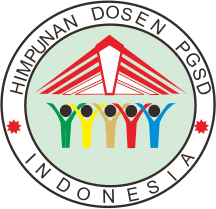Penerapan model pembelajaran means ends analysis (MEA) untuk meningkatkan kemampuan menganalisis materi FPB dan KPK pada peserta didik kelas IV sekolah dasar
Abstract
Keywords
Full Text:
PDFReferences
K. Jafar Sidik Nugroho, Hasan Mahfud 2017 Penerapan Model Means Ends Analysis (MEA) untuk Meningkatkan Kemampuan Menyelesaikan Soal Cerita Mata Pelajaran Matematika pada Siswa Sekolah Dasar J. Didakt. Dwija Indria 5(4) 1-4 [2] M. Hosnan 2014 Pendekatan Saintifik dan Kontekstual dalam Pembelajaran Abad 21 Kunci Sukses Implementasi Kurikulum 2013 (Bogor: Ghalia Indonesia) [3] R. A. Sani 2019 Pembelajaran Berbasis HOTS (Higher Order Thinking Skills) (Tangerang: Tira Smart) [4] T. N. Irawati and M. Mahmudah 2018 Pengembangan Instrumen Kemampuan Berpikir Analisis Siswa SMP dalam Menyelesaikan Soal Pemecahan Masalah Matematika Kadikma 9(2) 1–11 [5] L. W. Anderson and D. R. Krathwohl 2010 Kerangka Landasan Untuk Pembelajaran, Pengajaran, dan Asasmen (Yogyakarta: Pustaka Pelajar) [6] Sitthipon 2012 Development of teachers’ learning management emphasizing onanalytical thinking in Thailand Procedia-Social Behav. Sci 46 3339–3344 [7] Pilten and Ghuiz 2010 Evaluation of the skills of 5th grade primary school students’ high-order thinking levels in reading Procedia Soc. Behav. Sci 2 1326–1331 [8] M. Juanda, R. Johar, and M. Ikhsan 2014 Peningkatan Kemampuan Pemecahan Masalah dan Komunikasi Matematis Siswa SMP melalui Model Pembelajaran Means-ends Analysis ( MeA ) J. Kreano 5(2) 106 [9] Y. N. Sari 2018 Pengaruh Penerapan Model Pembelajaran Means Ends Analysis Menggunakan Media Video terhadap Keaktifan Belajar Peserta Didik pada Mata Pelajaran Ekonomi di SMA Negeri 3 Pagar Alam J. Profit 5(1) 89–104 [10] M. Huda 2014 Model-Model Pengajaran dan Pembelajaran: Isu-Isu Metodis dan Paradigmatis (Yogyakarta: Pustaka Pelajar) [11] Y. Pratama, S. Sariyatun, and H. Joebagio 2017 The development of Means-Ends Analysis and Value Clarification Technique Integration Model to explore the local Wisdom in Historical Learning J. Educ. Learn 11(2) 179-187 [12] A. Shoimin 2016 68 Model Pembelajaran Inovatif dalam Kurikulum 2013 (Yogyakarta: ArRuzz Media) [13] Ngalimun 2016 Strategi dan Model Pembelajaran (Yogyakarta: Aswaja Pressindo) [14] K. . Lestari and M. . Yudhanegara 2015 Penelitian Pendidikan Matematika (Bandung: PT Refika Aditama) [15] Sugiyono 2015 Metode Penelitian Pendidikan (Pendekatan Kuantitatif, Kualitatif, dan R&D) (Bandung: Alfabeta)
Refbacks
- There are currently no refbacks.



